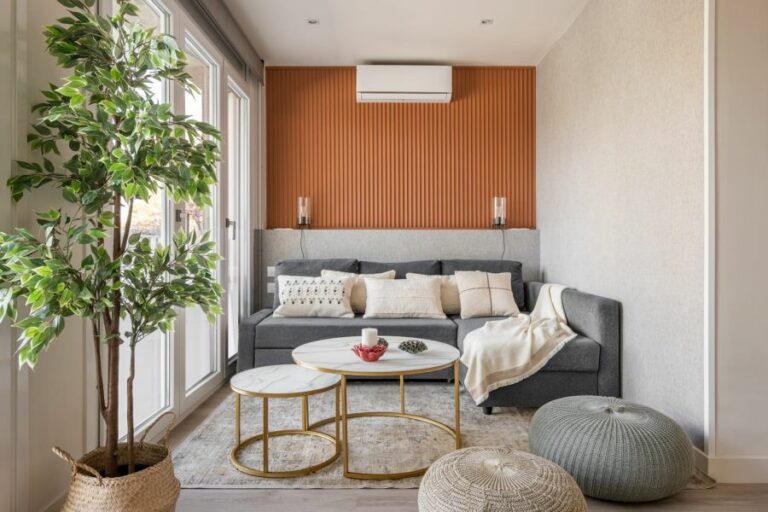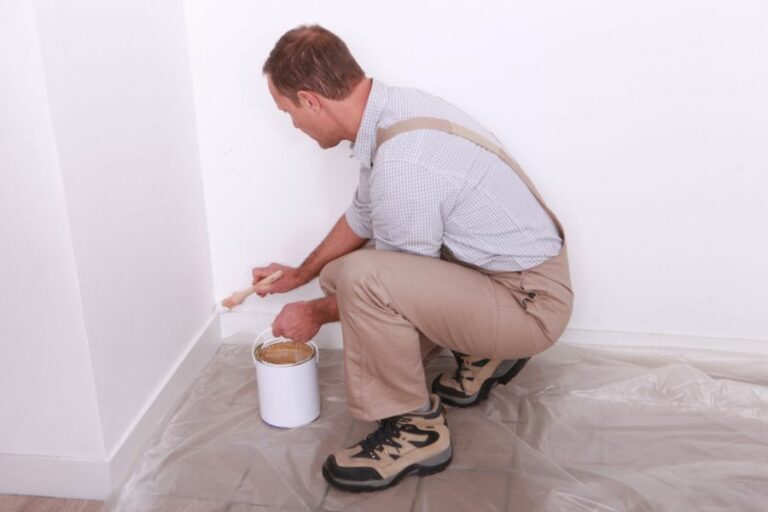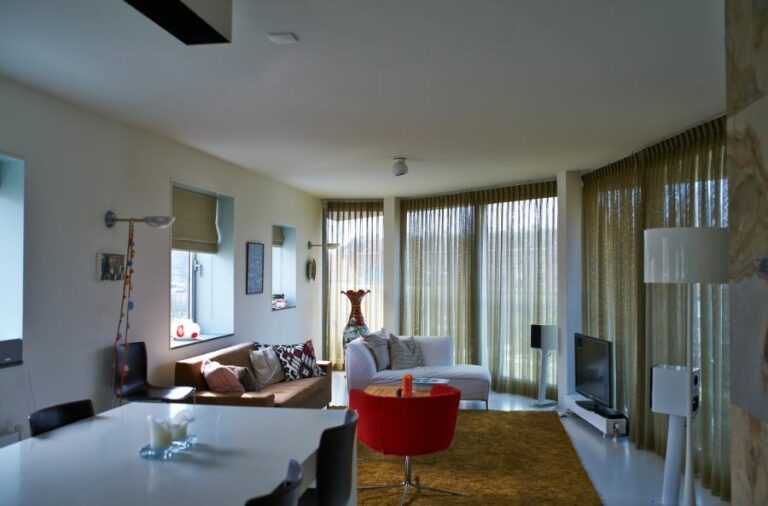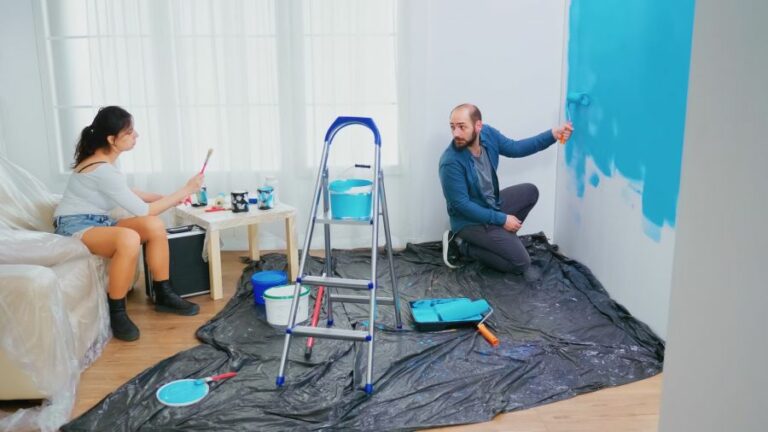Transforming Small Interiors With Paint. What Pros Say
Are you struggling with limited space in your home and unsure how to make it appear larger? Worry no more because we have the perfect solution! Our expertise in transforming small interiors using paint will allow you to create the illusion of spacious, open rooms that feel welcoming and refreshed.
Transforming small interiors with paint:>
To transform small interiors with paint, opt for light, neutral tones, or cool colors to make the room appear larger. Use paint techniques like vertical/horizontal stripes or painted ceilings to create an illusion of height or width, and consider accent walls for depth. Enhance the space further with accessories like mirrors, multi-functional furniture, and layered lighting.

Unlock the power of paint to transform your small interior spaces! Discover how the right color schemes, techniques, and applications can make even the tiniest rooms feel spacious and inviting. Read on to explore these game-changing ideas that will redefine your living space!
Contents
- 1 Revolutionizing Tiny Spaces with Paint Techniques
- 2 Enhancing a Compact Room’s Size through Paint Effects
- 3 Best Paint Colors to Amplify Smaller Rooms
- 4 Revitalizing Your Space with Modern Paint Styles
- 5 Paint Colors to Create a Cozier Atmosphere in a Room
Revolutionizing Tiny Spaces with Paint Techniques
A small interior space can sometimes feel cramped and unwelcoming. However, with the right paint techniques and creative ideas, you can transform any small room into a cozy and inviting environment.
• Choosing the Right Paint Colors
When selecting paint colors for a small interior, it’s essential to consider the effect of each color on the perceived size of the room. Lighter colors generally make a room appear larger and more open, whereas dark colors can create a cozy, intimate atmosphere. Let’s dive into some specific color recommendations:
– Light, Neutral Tones
I recommend choosing light, neutral tones for small interiors. Colors such as beige, soft gray, or light cream can make a room appear larger while providing a versatile backdrop for furniture and accessories.
– Cool Color Family
Cool colors, such as blues and greens, can create a sense of depth and have a visually calming effect. Pale shades of these colors are especially effective in opening up small spaces. For example, a soft mint green or sky blue can create a soothing atmosphere in a small living room or bedroom.
– Color Combinations
If you want to incorporate multiple colors into your small interior, consider using color combinations that visually enhance the room’s size. Try pairing a light, neutral tone with a deeper, contrasting color to create a sense of depth.
For example, you might paint the walls a pale gray and add dark blue accents for an elegant, cohesive look.
• Paint Techniques That Make a Difference
In addition to selecting the right paint colors, applying specific paint techniques can significantly impact the perceived size and atmosphere of a small room. Here are some tried-and-true techniques that have worked well in my experience:
– Vertical or Horizontal Stripes
Painting stripes on your walls can create the illusion of height or width, depending on the orientation of the stripes. Vertical stripes draw the eye upwards, making the ceiling appear higher. Horizontal stripes, on the other hand, can make the room seem wider.
Just be sure to keep the stripes relatively thin to avoid an overpowering effect.
– Painted Ceilings
While it’s common to leave ceilings white, painting them a coordinating or contrasting color can make a striking impact on a small interior. If you have a high ceiling, consider painting it a darker shade to make the room feel more intimate.
Alternatively, a light color on a low ceiling can create the illusion of added height.
– Accent Walls
Incorporating an accent wall is a popular technique for adding depth and visual interest to any room. For small interiors, choose a wall without doors or windows for the best effect.
An accent wall in a darker or contrasting color can create an eye-catching focal point while also making the room feel larger by adding depth.
• Enhancing Your Small Interior with Accessories and Lighting
Once you’ve tackled the paint, consider adding finishing touches with accessories and lighting to further enhance your small interior. Here are a few ideas to get you started:
– Mirrors
Adding mirrors to your small interior can make a big impact by reflecting light and creating the illusion of more space. Place mirrors on walls opposite windows to maximize the natural light in your room, or use a large, decorative mirror as a focal point on an accent wall.
– Multi-Functional Furniture
For small interiors, it’s important to maximize every inch of space. Consider incorporating multi-functional furniture, such as a sofa bed, storage ottoman, or built-in shelving, to make the most of your square footage.
– Layered Lighting
Incorporating various light sources at different levels can make a small room feel more spacious and inviting. Use a combination of floor lamps, table lamps, and wall sconces to create a cozy ambiance, and consider installing dimmer switches for added versatility.
By implementing these paint techniques and creative ideas, you can transform your small interior from cramped and unwelcoming to a cozy, inviting environment.
With the right paint colors, application techniques, and personal touches, any small room can become a beautiful, functional space you’ll enjoy spending time.
Enhancing a Compact Room’s Size through Paint Effects
• Choosing the Right Color Palette
When trying to make a small room appear larger, the color palette is crucial. Light and neutral colors, such as white, off-white, beige, or gray, are excellent choices for small spaces as they act as visual expanders.
Dark colors can make the room feel closed in and smaller. Hence, it’s essential to prioritize light shades over dark ones for the walls.
Benjamin Moore provides various ideas for expanding your room with the right wall colors. Their professional paint advisors can also offer personalized suggestions for your specific space.
• Opting for Monochromatic Colors
A monochromatic color scheme, where you use varying shades of a single color, can work wonders in making a small room look larger. By using different yet similar hues, you create a harmonious and visually calming environment, making the room feel more open.
For example, if you’re using a light gray as your primary wall color, consider painting the trim and molding with a slightly darker shade of gray. This subtle contrast creates an illusion of depth and space in a small room without overwhelming it.
• Using Vertical or Horizontal Stripes
One exciting way to make your room look larger is by using vertical or horizontal stripes on your walls. Vertical stripes make the room appear taller and more spacious, whereas horizontal stripes expand the space visually, making it look wider.
You can create these stripes using two contrasting shades of the same color or by choosing a single color and paint alternating stripes in a flat and glossy finish. Remember to use light and neutral colors for this paint effect, as it enhances the illusion of spaciousness.
For step-by-step instructions on creating perfect stripes, check out this tutorial by DIY Network.
• Adding Depth With Accent Walls
An accent wall, or a wall painted with a different color than the rest of the room, is another great way to create the illusion of more space. By adding a distinct color or pattern to one wall, you draw the eye’s attention away from the room’s size and toward the focal point created by the accent wall.
Keep the accent wall light and neutral, or choose a color that complements the other walls. You can also experiment with wallpaper or stencils to create unique patterns and textures, which further helps to enhance the room’s perceived dimensions.
• Utilizing Paint Techniques for Furniture and Decor
In addition to your walls, there are other ways to use paint to make a small room feel larger. Paint the furniture in a monochromatic color scheme to create a sense of unity and openness, or choose lighter furniture colors that blend with the wall color.
Additionally, consider using paint techniques such as color washing or sponging to create visual interest and depth on the walls, furniture, or architectural elements, further extending your room’s appearance.
• Succeeding With Proper Lighting
Proper lighting is essential to highlight the paint effects and make the room feel more expansive. Natural light is the best, so maximize it by using sheer window coverings or leaving the windows uncovered.
For artificial lighting, opt for multiple layers of light and use a combination of ceiling lights, floor lamps, and table lamps to evenly illuminate the room and create a sense of depth.
• Final Thoughts
In conclusion, there are various ways to make a small room look bigger using paint effects. By choosing the right color palette, incorporating monochromatic schemes, adding accent walls, using stripes, and applying paint techniques to furniture and decor, you’ll create an illusion of a larger, more open space.
Don’t forget the role of proper lighting in achieving the desired result. With some creativity and visual tricks, your small room can feel more expansive and inviting.
Paint Effect | Description |
|---|---|
Use lighter colors | Lighter colors create the illusion of openness and space, making the room look larger. |
Vertical stripes | Painting vertical stripes on the walls can make the room look taller and more spacious. |
Horizontal stripes | Painting horizontal stripes can make the room appear wider and more expansive. |
Use a monochromatic color scheme | Using different shades of the same color creates a sense of depth and makes the room feel larger. |
Paint the ceiling a lighter color | A lighter ceiling color can make the room feel taller and more open. |
Accent wall | Painting one wall a bold color or using a pattern can create a sense of depth, making the room look bigger. |
Mirror effect | Adding a large mirror or painting with reflective paint can create the illusion of extra space. |
Best Paint Colors to Amplify Smaller Rooms
Selecting the ideal paint color for a small room can be a challenge. After all, you want to create an atmosphere of openness and spaciousness, which doesn’t come easily in tight quarters.
• Light Colors: The Go-To Solution
Light colors are often recommended for small spaces because they tend to make rooms feel more open and airy. By reflecting an abundance of light, these shades can give the illusion of a larger space. Let’s delve deeper into some popular light color options.
– Neutrals: The Classic Choice
Neutral colors, like white, beige, and gray, are tried-and-true options for small rooms. These versatile shades work well with any decor style and help create a sense of spaciousness. Particularly, shades like off-white or light gray can make a small area feel more open without being stark or sterile.
Soft Creams: Warmth and Comfort
For those who prefer warmth and coziness in their spaces, soft cream and ivory tones are excellent options. These colors can make your small room feel inviting and comfortable while also giving the impression of more space.
– Pastels: The Soothing Option
Pastel colors, like pale blue or lavender, can also make a small room feel more expansive. These gentle shades have a calming effect and can help create a peaceful atmosphere in a cramped space.
– Cool Blues: Expansive and Airy
If you’re aiming for a more serene and open feel, cool blue tones are an ideal choice for small rooms. These colors can trick the eye into believing a space is larger and more open than it truly is, while also promoting a sense of tranquility.
• Strategic Use of Dark Colors
Though light colors are the conventional choice for making small rooms seem more spacious, using dark colors strategically can also create a sense of grandiosity.
– Accent Walls: Creating Depth
Incorporating a dark-colored accent wall in your small room can help create the illusion of depth. By combining a dark accent wall with lighter surrounding walls, you can guide the eye and make the room appear larger.
– Bold Contrast: Big Statements in Small Spaces
Including bold, dark colors in small doses can make a powerful statement in a small room. Integrating elements like a vivid area rug, a patterned throw pillow, or vibrant artwork can provide a lively contrast and make the space seem more dynamic.
• Don’t Forget the Ceiling
Ceilings are often overlooked when it comes to room design, but they too can play a role in making a small room feel bigger. Painting the ceiling a lighter color than the walls can give the illusion of height and openness.
• Tips for Maximizing Small Spaces
Besides wall colors, there are a few tricks you can use to make your small room feel more spacious:
– Utilize Mirrors
Mirrors effectively reflect more light into a space, making it appear larger. Including a large mirror or multiple smaller mirrors can drastically impact the sense of spaciousness in your small room.
– Employ Vertical Storage
By using vertical storage solutions, such as wall-mounted shelves and tall bookcases, you can draw the eye upwards and make the room seem taller.
– Opt for Minimalist Furniture
Selecting sleek, minimalist furniture can help avoid overcrowding a small space. Choosing furniture with exposed legs, narrow profiles, and glass or acrylic materials can contribute to an open feel.
– Embrace Natural Light
Exploit any source of natural light available in your small room to enhance its spaciousness. Opt for light, sheer curtains to provide privacy while permitting sunlight to filter through.
In conclusion, choosing the right color for your small room can go a long way in making it appear more open and spacious. From utilizing light colors to strategically incorporating dark shades, you have ample options to transform your tiny space into a seemingly grand area.
Remember to make use of mirrors, vertical storage, and minimalist furniture to further amplify the sense of space in your small room. By considering these factors and employing these tricks, you’ll be well on your way to creating a beautiful, spacious-feeling room, regardless of its actual dimensions.
Revitalizing Your Space with Modern Paint Styles
As a seasoned interior designer, I have seen firsthand the transformative power of paint. A fresh coat of paint can dramatically modernize a room, adding new life to dated spaces and creating a fresh, contemporary atmosphere.
• Color Selection Essentials
Choosing the right color is crucial when aiming to modernize a space. Gone are the days of beige and off-white dominating the world of interior design. Today, contemporary color palettes tend to focus on muted, sophisticated tones that create a sense of tranquility and cohesion.
– Cool and Neutral Tones
I recommend selecting cool and neutral tones such as soft grays, blues, and greens, as these colors help create a sleek, clean look. A pale, cool gray is an especially popular choice for creating a sophisticated, modern ambiance.
– Bold Accent Colors
Integrating a bold accent color can also provide an instant contemporary update. Opting for a single saturated hue or a vibrant pattern can help liven up a room, making it feel fresh and exciting. Colors and patterns that tend to work well as accents include deep blues, teals, and geometric prints.
• Painting Techniques for a Modern Look
There are endless possibilities when it comes to painting techniques that can make a room feel modern and updated. From color blocking to ombre effects, I will discuss several methods that can create a unique and contemporary space.
– Color Blocking
Color blocking, a technique that involves using two or more contrasting colors in the same room, has gained immense popularity in recent years. This technique can be applied to horizontal, vertical, or irregularly shaped sections of the wall for a fun and modern aesthetic.
For an added touch of sophistication, consider incorporating metallic or glossy finishes into your color block design.
– Ombr and Gradient Effects
Ombr and gradient effects are another fantastic way to modernize a room with paint. These techniques involve gradually blending one color into another to create a smooth or subtle transition.
This can be done horizontally or vertically, depending on your preference, and is often easiest with water-based paint.
– Textured Paints and Finishes
There are various types of textured paints and finishes on the market today that can lend a modern, industrial touch to a room. From concrete and metallic effect paint to sand texture formulations, these products can create the illusion of depth and dimension on flat surfaces.
I recommend experimenting with these products in a small area before committing to a large-scale application.
• Popular Modern Room Styles and Paint Palettes
Understanding the popular modern room styles and their corresponding paint palettes can help facilitate the process of choosing the right colors and techniques for your space. Here are a few popular design styles and associated color schemes that can inspire your modern room transformation.
The Scandinavian style is characterized by simplicity, functionality, and minimalism. Opt for a neutral color palette in this design style, utilizing variations of muted grays, creams, and pale blues. Accent colors can include sage green or dusky pink for an elegant, contemporary look.
– Industrial
Industrial design is modern and urban, often combining raw materials like metal, exposed brick, and concrete. In this style, colors should be muted and earthy, emphasizing neutral shades of gray, black, and white.
To create contrast amidst the neutral backdrop, consider incorporating dark, warm tones such as burgundy, emerald green, or navy blue.
– Midcentury Modern
Midcentury modern design is all about clean lines, geometric shapes, and a sense of playfulness. In this style, color plays a significant role in establishing a retro yet contemporary feel. Consider incorporating saturated hues like mustard yellow, teal, and burnt orange to create a lively and inviting atmosphere.
• Conclusion
To modernize a room with paint, focus on creating a contemporary color palette, experimenting with different painting techniques, and understanding popular modern design styles. By considering these factors and selecting the right colors and methods, you can transform any dated space into a modern haven.
For more information and inspiration on modernizing a room with paint, visit the Color Matters website, which offers valuable insights into color theory and design principles.
Step | Description |
|---|---|
1 | Choose a modern color palette. Consider shades of gray, white, or other neutral colors. |
2 | Decide on accents or complementary colors. These can be used for trim, furniture, or accessories. |
3 | Prep the room by removing furniture, covering floors, and cleaning any dirt or grease from walls. |
4 | Prime the walls if necessary. This helps the new paint adhere and promotes an even finish. |
5 | Begin painting the walls with your chosen modern color, using proper techniques to ensure an even application. |
6 | Paint any trim or molding in a complementary color, or even the same color as the walls for a monotone look. |
7 | Consider adding an accent wall or patterns to break up the monotony and add visual interest to the room. |
8 | Once the paint is dry, put the room back together and incorporate modern accessories, furniture, or art to complete the transformation. |
Paint Colors to Create a Cozier Atmosphere in a Room
• Importance of Color Choice
Choosing the appropriate color for a room is an essential part of interior design, as it influences not only the ambiance but also how the space is perceived.
In the world of design, certain colors are known for making rooms feel more spacious, while others achieve the opposite effect, making them seem more compact.
– Colors that Create a Cozy Atmosphere
Darker colors tend to make a room appear smaller, as they absorb light rather than reflect it. It is worth mentioning that certain dark colors can also create a warm, cozy atmosphere, so keep this in mind when selecting colors.
- Black: Often associated with elegance and sophistication, black has the power to make a room feel extremely small. However, it can also provide a bold, dramatic touch, which works well in certain spaces like a powder room, a dining room, or an accent wall. Just be aware of the potential caveats.
- Navy Blue: Known for its calming properties, navy blue is a versatile color that can work in various room styles. However, using it on all walls can make a space feel smaller and more enclosed. To balance the effect of navy, consider pairing it with lighter colors or strategically placing mirrors to reflect the available light.
- Deep Purple: Indicative of luxury and royalty, a deep purple creates a rich, intimate feeling but can make a room feel very small if used excessively. To counteract this, consider utilizing deep purple as an accent color alongside lighter shades.
- Dark Green: A bold choice, dark green can evoke feelings of serenity and tranquility yet can also make a room feel tighter. With this in mind, opt for using dark green sparingly, perhaps on an accent wall or in combination with lighter shades of green.
– Combining Colors for a Balanced Effect
If your goal is to make a space appear smaller while still retaining a pleasant atmosphere, consider employing the following techniques when combining colors:
- Wall and Ceiling Colors: Painting the walls and ceiling the same color, especially a dark shade, will make the room look smaller as it blurs the boundaries between the two surfaces.
- Contrast: High contrast between the colors of walls, furniture, and other elements in the room can create a visually busy space, which makes it feel smaller. Opting for monochrome, low-contrast color schemes can help achieve the desired effect.
- Patterned Wallpaper: Busy patterns or large-scale designs on the walls can make a room feel more compact, particularly if the pattern includes dark colors.
- Furniture: The size, color, and placement of furniture in a room can also influence the perception of space. Large, dark, bulky pieces of furniture can make a room appear smaller, as can arranging them close together.
– Expert Recommendations
While the above suggestions provide general guidance regarding colors that can make a room appear smaller, personal preference and individual experiences play a significant role in choosing paint colors. With this in mind, I recommend the following:
- Sampling: Before committing to painting an entire room, acquire samples of your chosen color or colors and test them on the walls. Observe how the color appears in different lighting conditions to make sure you are happy with the result.
- Consulting a Professional: If you are unsure about the color choice, seeking the advice of an interior designer or a color consultant can help provide personalized guidance and expert recommendations based on your unique space and preferences.
- Experimentation: When it comes to interior design, sometimes the best ideas come through trial and error. Don’t be afraid to take risks and experiment with different colors and combinations to make a room feel smaller or larger, depending on your desired outcome.
In conclusion, while there is no one-size-fits-all answer regarding paint colors that make a room look smaller, it’s clear that darker shades, high contrast, and busy patterns typically contribute to a reduced sense of space.
Ultimately, be guided by personal preference, seek expert advice if needed, and don’t be afraid to experiment until you find the perfect balance for your space.







